Yamaha REV500 User Manual
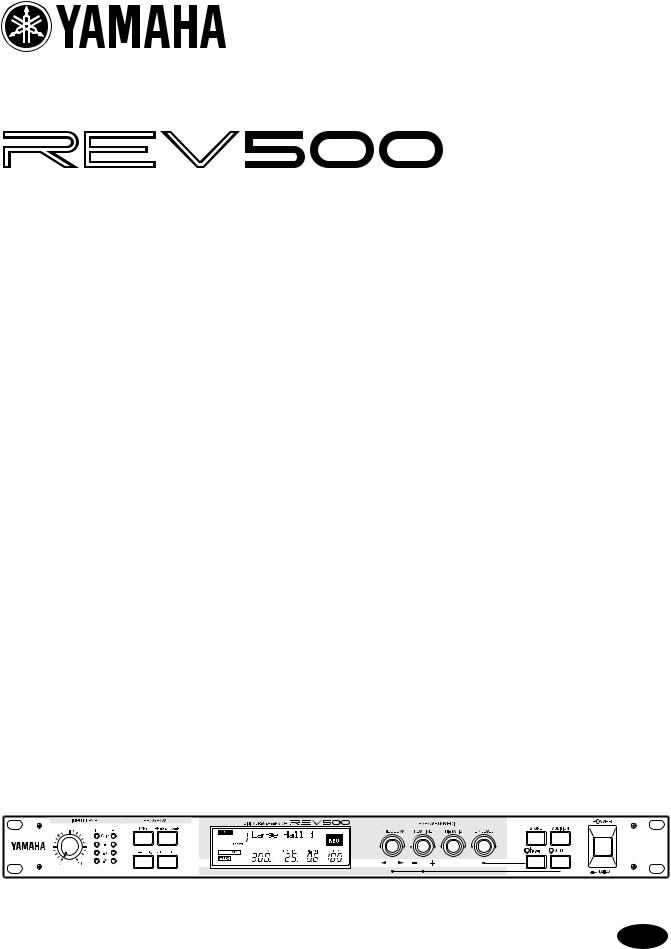
DIGITAL REVERBERATOR
Operation Manual Manuel d’instructions Bedienungsanleitung Manual de Operación
M
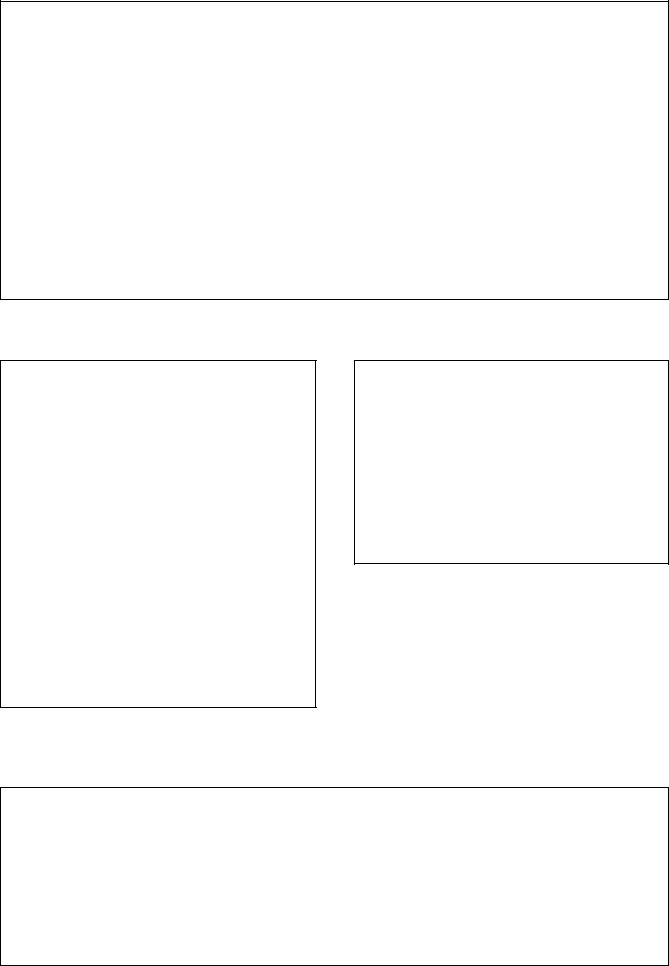
FCC INFORMATION (U.S.A.)
1.IMPORTANT NOTICE: DO NOT MODIFY THIS UNIT!
This product, when installed as indicated in the instructions contained in this manual, meets FCC requirements. Modifications not expressly approved by Yamaha may void your authority, granted by the FCC, to use the product.
2.IMPORTANT: When connecting this product to accessories and/or another product use only high quality shielded cables. Cable/s supplied with this product MUST be used. Follow all installation instructions. Failure to follow instructions could void your FCC authorization to use this product in the USA.
3.NOTE: This product has been tested and found to comply with the requirements listed in FCC Regulations, Part 15 for Class "B" digital devices. Compliance with these requirements provides a reasonable level of assurance that your use of this product in a residential environment will not result in harmful interference with other electronic devices. This equipment generates/uses radio frequencies and, if not installed and used according to the instructions found in the users manual, may cause interference harmful to the operation of other electronic devices. Compliance with FCC regulations does not guarantee that interference will not occur in all installations. If this product is found to be the source of interference, which can be determined by turning the unit "OFF" and "ON", please try to eliminate the problem by using one of the following measures:
Relocate either this product or the device that is being affected by the interference.
Utilize power outlets that are on different branch (circuit breaker of fuse) circuits or install AC line filter/s.
In the case of radio or TV interference, relocate/reorient the antenna. If the antenna lead-in is 300 ohm ribbon lead, change the lead-in to coaxial type cable.
If these corrective measures do not produce satisfactory results, please contact the local retailer authorized to distribute this type of product. If you can not locate the appropriate retailer, please contact Yamaha Corporation of America, Electronic Service Division, 6600 Orangethorpe Ave, Buena Park, CA 90620
* This applies only to products distributed by YAMAHA CORPORATION OF AMERICA.
IMPORTANT NOTICE FOR
THE UNITED KINGDOM
Connecting the Plug and Cord
WARNING: THIS APPARATUS MUST BE EARTHED
IMPORTANT: The wires in this mains lead are coloured in accordance with the following code:
GREEN-AND-YELLOW : EARTH
BLUE |
: NEUTRAL |
BROWN |
: LIVE |
As the colours of the wires in the mains lead of this apparatus may not correspond with the coloured markings identifying the terminals in your plug, proceed as follows:
The wire which is coloured GREEN-AND-YELLOW must be connected to the terminal in the plug which is marked by the letter E or by the safety earth symbol  or coloured GREEN-AND-YELLOW.
or coloured GREEN-AND-YELLOW.
The wire which is coloured BLUE must be connected to the terminal which is marked with the letter N or coloured BLACK.
The wire which is coloured BROWN must be connected to the terminal which is marked with the letter L or coloured RED.
*This applies only to products distributed by YAMAHA KEMBLE MUSIC (U.K.) LTD.
ADVARSEL!
Lithiumbatteri–Eksplosionsfare ved fejlagtig håndtering. Udskiftning må kun ske med batteri af samme fabrikat og type. Levér det brugte batteri tilbage til leverandoren.
VARNING
Explosionsfara vid felaktigt batteribyte. Använd samma batterityp eller en ekvivalent typ som rekommenderas av apparattillverkaren. Kassera använt batteri enligt fabrikantens instruktion.
VAROITUS
Paristo voi räjähtää, jos se on virheellisesti asennettu. Vaihda paristo ainoastaan laitevalmistajan suosittelemaan tyyppiin. Hävitä käytetty paristo valmistajan ohjeiden mukaisesti.
NEDERLAND
•Dit apparaat bevat een lithium batterij voor geheugen back-up.
•Raadpleeg uw leverancier over de verwijdering van de batterij op het moment dat u het apparaat ann het einde van de levensduur afdankt of de volgende Yamaha Service Afdeiing:
Yamaha Music Nederland Service Afdeiing Kanaalweg 18-G, 3526 KL UTRECHT Tel. 030-2828425
•Gooi de batterij niet weg, maar lever hem in als KCA.
THE NETHERLANDS
•This apparatus contains a lithium battery for memory back-up.
•For the removal of the battery at the moment of the disposal at the end of the service life please consult your retailer or Yamaha Service Center as follows:
Yamaha Music Nederland Service Center Address: Kanaalweg 18-G, 3526 KL UTRECHT Tel: 030-2828425
•Do not throw away the battery. Instead, hand it in as small chemical waste.
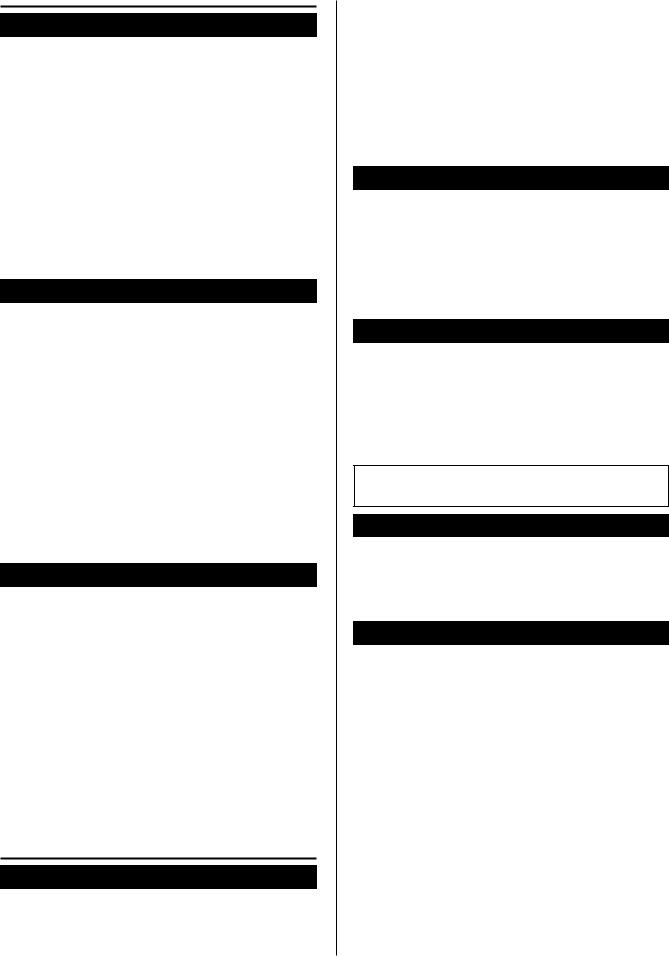
Precautions
WARNING
Installation
•Connect this unit's power cord only to an AC outlet of the type stated in this Owner's Manual or as marked on the unit. Failure to do so is a fire and electrical shock hazard.
•Do not allow water to enter this unit or allow the unit to become wet. Fire or electrical shock may result.
•Do not place a container with liquid or small metal objects on top of this unit. Liquid or metal objects inside this unit are a fire and electrical shock hazard.
•Do not place heavy objects, including this unit, on top of the power cord. A damaged power cord is a fire and electrical shock hazard. In particular, be careful not to place heavy objects on a power cord covered by a carpet.
Operation
•Do not scratch, bend, twist, pull, or heat the power cord. A damaged power cord is a fire and electrical shock hazard.
•Do not remove the unit's cover. You could receive an electrical shock. If you think internal inspection, maintenance, or repair is necessary, contact your dealer.
•Do not modify the unit. Doing so is a fire and electrical shock hazard.
•If lightning begins to occur, turn off the power switch of the unit as soon as possible, and unplug the power cable plug from the electrical outlet.
•If there is a possibility of lightning, do not touch the power cable plug if it is still connected. Doing so may be an electrical shock hazard.
In case an abnormality occurs during operation
•If the power cord is damaged (i.e., cut or a bare wire is exposed), ask your dealer for a replacement. Using the unit with a damaged power cord is a fire and electrical shock hazard.
•Should this unit be dropped or the cabinet be damaged, turn the power switch off, remove the power plug from the AC outlet, and contact your dealer. If you continue using the unit without heeding this instruction, fire or electrical shock may result.
•If you notice any abnormality, such as smoke, odor, or noise, or if a foreign object or liquid gets inside the unit, turn it off immediately. Remove the power cord from the AC outlet. Consult your dealer for repair. Using the unit in this condition is a fire and electrical shock hazard.
CAUTION
Installation
•Keep this unit away from the following locations:
-Locations exposed to oil splashes or steam, such as near cooking stoves, humidifiers, etc.
-Unstable surfaces, such as a wobbly table or slope.
-Locations exposed to excessive heat, such as inside a car with all the windows closed, or places that receive direct sunlight.
-Locations subject to excessive humidity or dust accumulation.
•Hold the power cord plug when disconnecting it from an AC outlet. Never pull the cord. A damaged power cord is a potential fire and electrical shock hazard.
•Do not touch the power plug with wet hands. Doing so is a potential electrical shock hazard.
Operation
•Turn off all musical instruments, audio equipment, and speakers when connecting to this unit. Use the correct connecting cables and connect as specified.
•If you know you will not use this unit for a long period of time, such as when going on vacation, remove the power plug from the AC outlet. Leaving it connected is a potential fire hazard.
Maintenance
•To prevent electrical shock when cleaning the unit, remove the power plug from the AC outlet.
•The inside of the unit should be cleaned periodically. Dust accumulation inside the unit may cause malfunction and is a potential fire hazard. Consult your dealer for information about cleaning.
PRECAUTIONS FOR OPERATION - FOR CORRECT OPERATION -
Interference with other electronic devices
•The digital circuits of this unit may induce a slight noise into nearby radios and TVs. If noise occurs, relocate the affected equipment.
Backup battery
•The REV500 has a long-life lithium battery that maintains the contents of the user memory even when the REV500 is off. Under normal use, the battery should last several years. However, Yamaha strongly recommends that you have the battery replaced by a qualified Yamaha service center every five years, to prevent the accidental loss of valuable data.
•Should the battery’s voltage fall below a certain level, the message “LOW BATTERY” will appear in the LCD when you turn the REV500 on. If this happens, it means that contents of your REV500’s user memory have been lost. Have the backup battery replaced immediately.
•Prompt and regular replacement of the back-up battery is necessary to prevent the loss of important data. In addition, if possible, you should use the MIDI bulk dump function (see page 17) regularly to store backup copies of your REV500’s data in a MIDI sequencer other MIDI device. This will allow you to recover your data should the back-up battery run down sooner than you think.
Introduction
Congratulations on your purchase of a Yamaha REV500 Digital Reverberator! The REV500 is a high-quality, inexpensive, and easy-to-use digital reverberator, suitable for home recording or smaller sound reinforcement applications.
A true stereo processor with two inputs and two outputs, the REV500 offers high-quality stereo reverb, either alone or in combination with a variety of other effects. The 20-bit A/D and D/A converters feature a 44.1 kHz sampling rate, for superb sound quality and wide frequency response. The REV500 comes complete with 100 preset programs that take excellent advantage of this high-performance hardware, plus room for 100 more programs that you can edit for yourself.
The REV500 is also flexible and simple to use. It lets you use either 1/4" phone or XLR connectors for both input and output, and gives you the option of +4 dB input and output levels. Four rotary controls allow quick and easy editing of the basic program parameters. And MIDI IN and OUT terminals allow remote program selection, remote data storage, and realtime control of program parameters using MIDI messages.
To get the most out of your REV500 Digital Reverberator, please read this manual thoroughly and keep it on hand for future reference.
Contents |
|
Controls ........................................................... |
1 |
Front Panel .................................................................... |
1 |
Rear Panel ..................................................................... |
2 |
Installation and Connections ........................................ |
2 |
Using the REV500 ........................................... |
3 |
Selecting Programs ....................................................... |
3 |
Testing Programs .......................................................... |
3 |
Automatic Demonstration ............................................ |
3 |
REV500 Preset Program List ....................................... |
4 |
Editing Programs ............................................ |
8 |
Editing Basic Parameters .............................................. |
8 |
Changing the Effect Level ............................................ |
9 |
Realtime Parameter Control ......................................... |
9 |
Editing Internal Parameters .......................................... |
9 |
Changing a Program’s Title ......................................... |
9 |
Internal Parameter List ............................................... |
10 |
Saving Edited Programs ............................................. |
13 |
System Functions ......................................... |
14 |
Selecting an Input Mode ............................................. |
14 |
Selecting an Output Mode .......................................... |
14 |
Setting the Footswitch Function ................................. |
14 |
Adjusting the Audition Function ................................ |
15 |
Changing the Initial Title Display .............................. |
15 |
Initializing the REV500’s User Memory ................... |
15 |
Using MIDI Functions ................................... |
16 |
Selecting a MIDI Channel .......................................... |
16 |
Using the MIDI OUT Function .................................. |
16 |
Editing the MIDI Program Change Map .................... |
16 |
Storing Data with MIDI Bulk Dumps ........................ |
17 |
Appendix ........................................................ |
18 |
Guide to Utility Mode Functions ............................... |
18 |
Specifications .............................................................. |
19 |
Dimensions ................................................................. |
20 |
MIDI Data Format ............................................... |
Add-1 |
MIDI Implementation Chart ................................ |
Add-3 |
Program Data Sheet ............................................. |
Add-4 |

Controls
Front Panel
1 |
2 |
|
3 |
||||||
|
|
|
|
|
|
|
|
|
|
|
|
|
|
|
|
|
|
|
|
|
|
|
|
|
|
|
|
|
|
|
|
|
|
|
|
|
|
|
|
|
|
|
|
|
|
|
|
|
|
1INPUT LEVEL control and meter
The INPUT LEVEL control sets the input level for both the right and left input channels. It is accompanied by a stereo LED meter that shows the levels of the signals received by the REV500 after A/D conversion. Lighting of the red CLIP LEDs thus indicates clipping of the digital signal. You should adjust the control so that the CLIP LEDs do not light.
2PROGRAM keys
These keys let you choose the program that the REV500 will use to process the input sound.
The TYPE key selects the type of effect program to be used: HALL, ROOM, PLATE, or SPECIAL. The current program type selection is displayed in the upper left corner of the LCD.
The PRESET/USER key selects between the PRESET and USER program memory areas. The currently selected memory area is displayed under the program number in the LCD. It is possible to change the parameters of a preset program, but the edited program must be stored as a user program.
The NUMBER keys are used to select different programs within the chosen program type and memory area. The number and title of the currently selected program are displayed in the top row of the LCD.
3LCD
This LCD normally displays information about the currently selected program. It also displays graphic information about basic parameters being edited, as well as a variety of other messages related to the REV500’s utility functions.
45 6 7 8 9
4PARAMETER EDIT controls
These controls let you edit the basic parameters of the selected program.
The PRE DELAY control sets the amount of time that will elapse before the onset of early reflections. It also functions as a cursor control, which you can turn to select the parameter or character to be modified when using the REV500’s utility functions.
The REV TIME control sets the amount of time needed for the reverberation to decay. It also functions as a data entry control, which you can turn to change the values of selected items when using the REV500’s utility functions.
The HI-RATIO control sets the reverb time for the highfrequency components of the reverb, as a proportion of the overall reverb time set using the REV TIME control.
The ER LEVEL control sets the level of the early reflection component of the reverb. It is also used, in combination with the EFF LEVEL key, to adjust the overall effect output level.
5EFF LEVEL key and LED
This key lets you use the ER LEVEL control to set the overall effect output level. When the LED above this key is lit, the ER LEVEL control will adjust the effect level instead of the early reflection level.
6STORE key
This key is used to store modified programs, and to execute MIDI bulk dumps.
1
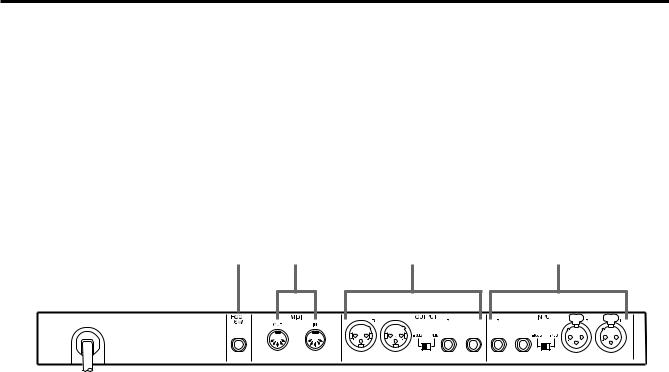
7AUDITION key
This key causes the REV500’s internal tone generator to play a sound, allowing you to check the effect of the currently selected program. A utility function (see page 15) allows you to select one of two sounds for this key to play, and to set the REV500 to play this sound once or repeatedly when the AUDITION key is pressed.
Rear Panel
0 A
0FOOT SW connector
This 1/4" phone jack allows you to connect a Yamaha FC5 footswitch, for hands-free remote control of your REV500. You can use the FC5 footswitch either to mute the REV500’s effect output, or to advance the current program selection.
AMIDI terminals
The REV500 sends and receives MIDI data via these connectors.
BOUTPUT connectors and output level switch
These are balanced output jacks that output the analog return signal from the REV500 to your mixer, multitrack recorder, or other audio equipment. A pair of XLR connectors and a pair of 1/4" phone jacks are provided. If you desire monophonic output, insert the plug in the left
(L) connector only. The output level switch selects either –10 dB or +4 dB as the nominal output level.
8UTILITY key and LED
This key lets you access the REV500’s utility functions, which include MIDI settings and system-related functions. The LED above this key will light when a utility function is being used. See page 18 for a summary of the functions that can be accessed using this key.
9POWER switch
This switch turns the REV500 on and off.
BC
CINPUT connectors and input level switch
These are balanced input jacks that receive the analog signal from your mixer, multitrack recorder, or other audio equipment. A pair of XLR connectors and a pair of 1/4" phone jacks are provided. If the sound source to be processed is monophonic, insert the plug in the left (L) connector only. Also, be sure to set the REV500 to use mono input (refer to page 14). The input level switch selects either –10 dB or +4 dB as the nominal input level.
Do not connect jacks to both the XLR and 1/4" phone INPUT connectors, as doing so may adversely affect the performance of the REV500.
Installation and Connections
Before attempting to use your REV500, make sure that you have carefully read and understood the precautions inside the front cover of this manual.
Mount the REV500 in a rack, or place it in a location where it is safe and stable. Make sure that the POWER switch is off before making any connections. Plug in the power cord, and connect the REV500’s input and output connectors to your mixer, multitrack recorder, or other audio equipment using appropriate cables.
Press the POWER switch to turn the REV500 on.
2
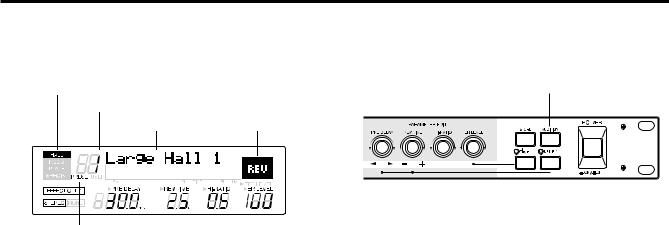
Using the REV500
Selecting Programs
Program type |
|
Program number |
|
Program title |
Effect type |
Program memory
You can use the PROGRAM keys to select a desired program, as described below. (Note that the following steps do not have to be performed in the order listed.)
1.Select a program type.
Use the PROGRAM TYPE key to select a program type. The REV500 has four program types: HALL, ROOM, PLATE, and SPECIAL. Each program type contains 25 programs, as described in the REV500 Preset Program List on pages 4 through 7.
The current program type selection is displayed in the upper left corner of the LCD.
2.Select a program memory.
Press the PRESET/USER key to switch between the preset and user program memory areas. When you first use the REV500, you will find that both memory areas contain the same selection of programs. The contents of the USER memory will gradually change as you edit programs and store the results, as explained in the following chapter.
The currently selected memory area is displayed under the program number in the LCD.
3.Select a program number.
Use the PROGRAM NUMBER keys to choose one of the programs in the program type and memory are you have selected. You can press these keys once to increase or decrease the current program number selection by one, or hold them down to scan through the programs.
The number and title of the current program are displayed in the top row of the LCD.
The effect type of the current program is also displayed in the upper right corner of the LCD. (Refer to pages 10 through 13 for details regarding effect types.)
Testing Programs
AUDITION key
You can use the REV500’s handy audition function to check the effect produced by a program when it’s inconvenient to run your actual sound source through the REV500. Just press the AUDITION key in the upper right corner of the front panel. The REV500’s internal tone generator will produce a tone that lets you hear how the program you’ve selected affects the output sound.
You can select one of two sample tones—either a snare drum or a rim shot—using the DEMO TONE TRIG utility function described on page 15. This function also lets you determine whether pressing the AUDITION key will cause the tone to sound once or repeatedly.
If you set the audition function to play repeatedly, you can stop it by pressing the AUDITION key a second time.
Automatic Demonstration
The REV500 has a demonstration mode that lets you hear samples of some typical effect settings. To select demonstration mode, hold down the UTILITY key and press AUDITION.
Important: If you select the demonstration mode while editing a program, the program will be reset and any changes you have made will be lost. Be sure to save important program data before selecting the demonstration mode. (Refer to page 13 for instructions on how to store a program.)
3

REV500 Preset Program List
HALL
No. |
Title |
Effect Type* |
Description |
|
|
|
|
1 |
Large Hall 1 |
REVERB |
Standard hall-type reverbs that simulate large halls with good acoustics. May be |
|
|
|
|
2 |
Large Hall 2 |
|
used with any instrument. “Large Hall 1” is bright; “Large Hall 2” is slightly darker. |
|
|
|
|
3 |
Empty Hall |
REVERB |
A reverb that simulates the feel of a large hall with no audience. |
|
|
|
|
4 |
Big Slap Hall |
REVERB |
A bright reverb with breadth, thanks to slightly emphasized early reflec- |
|
|
|
tions. |
|
|
|
|
5 |
Arena |
REVERB |
A reverb with the low-range characteristics of an arena-sized concert space. |
|
|
|
|
6 |
New Hall |
REVERB |
A bright reverb with a punch. |
|
|
|
|
7 |
Wonder Hall |
REVERB |
A light, bright hall reverb. Good with percussion. |
|
|
|
|
8 |
Dark Hall |
REVERB |
A rather dark hall reverb. Recommended for use with songs in minor keys. |
|
|
|
|
9 |
Church 1 |
REVERB |
Reverbs that simulate the acoustics of high-vaulted cathedrals. “Church 1” |
|
|
|
|
10 |
Church 2 |
|
is dark; “Church 2” is brighter, with more reflections. |
|
|
|
|
11 |
Medium Hall 1 |
REVERB |
Standard medium-sized hall reverbs. “Medium Hall 1” is bright, with many |
|
|
|
|
12 |
Medium Hall 2 |
|
reflections; “Medium Hall 2” is dark and dense. |
|
|
|
|
13 |
Concert Hall |
REVERB |
A hall-type reverb with natural-sounding acoustics. |
|
|
|
|
14 |
Small Hall 1 |
REVERB |
Reverbs that simulate acoustically ideal small halls. “Small Hall 1” is |
|
|
|
|
15 |
Small Hall 2 |
|
bright and live-sounding; “Small Hall 2” is somewhat darker. |
|
|
|
|
16 |
Gothic Hall |
REV+CHO |
A hall reverb with a growling chorus attack. Good for vocals and solo |
|
|
|
instruments. |
|
|
|
|
17 |
Ballade Voc 1 |
REVERB |
Longish hall reverbs for use with slow vocals. “Ballad Voc 1” is bright |
|
|
|
|
18 |
Ballade Voc 2 |
|
and dense; “Ballad Voc 2” is dark and slightly less dense. |
|
|
|
|
19 |
Rev for Pads |
REV FLG |
A long reverb with flanged high ranges, for a spacy sound. Good with pad- |
|
|
|
type synths. |
|
|
|
|
20 |
Ensemble Rev |
REV FLG |
A short reverb with a warm flanger sound. Good for strings and organs. |
|
|
|
|
21 |
Chorus Reverb |
REV CHO |
A hall reverb with chorus added for extra thickness. Good with pianos and |
|
|
|
pad-type synths. |
|
|
|
|
22 |
Slapped Echo |
ECHO REV |
A reverb that captures the feel of an analog delay or tape echo. Good with |
|
|
|
vocals or solos. |
|
|
|
|
23 |
Flutter Hall |
REV GATE |
A gated hall reverb with a long pre-delay. |
|
|
|
|
24 |
Kick Gate |
REV GATE |
A gated hall reverb, intended for use with bass drums. |
|
|
|
|
25 |
Snare Gate |
REV GATE |
A gated hall reverb, intended for use with snare drums. |
|
|
|
|
* Refer to pages 10 through 13 for details regarding effect types.
4

ROOM
No. |
Title |
Effect Type* |
Description |
|
|
|
|
1 |
Large Room 1 |
REVERB |
A reverb that simulates a large room with hard walls, for a slightly quirky |
|
|
|
thick sound. |
|
|
|
|
2 |
Large Room 2 |
REVERB |
A large room reverb, slightly drier than “Large Room 1.” |
|
|
|
|
3 |
Live Gate Room |
REVERB |
A room reverb with a very live nonlinear sound. Good with drums and |
|
|
|
guitars. |
|
|
|
|
4 |
Live Room 1 |
REVERB |
Reverbs that simulate the sound of a room with live acoustics. Use “Live Room 1” to |
|
|
|
|
5 |
Live Room 2 |
|
simulate greater distance from the sound source, or “Live Room 2” for front-row seats. |
|
|
|
|
6 |
Bath Room |
REVERB |
A simulation of the reverb in a tile-walled bathroom. |
|
|
|
|
7 |
Medium Room |
REVERB |
A live-sounding reverb with the feel of a medium-sized recording studio. |
|
|
|
|
8 |
Garage |
REV GATE |
A reverb that simulates the sound of a garage performance. |
|
|
|
|
9 |
Ring Studio |
REVERB |
The nonlinear reverb sound of a small studio with emphatic high-range |
|
|
|
acoustics. |
|
|
|
|
10 |
Empty Store |
REVERB |
A reverb simulating a room with nothing in it. |
|
|
|
|
11 |
Add to Dry Mix |
REVERB |
A room reverb that can add live sound to a dry two-channel mix source. |
|
|
|
|
12 |
Heavy Bottom |
REVERB |
A room reverb with an emphasized low range, for a powerful sound. |
|
|
|
|
13 |
Bright Room 1 |
REVERB |
A bright room reverb with extra early reflections. |
|
|
|
|
14 |
Bright Room 2 |
REVERB |
A room reverb that sounds smaller, but more dense, than “Bright Room 1.” |
|
|
|
|
15 |
Small Room |
REVERB |
A standard small room simulation. |
|
|
|
|
16 |
Tiny Gate Room |
REVERB |
A somewhat dead nonlinear small room simulation. |
|
|
|
|
17 |
Wood Room |
REVERB |
A small room simulation, dark and dead. |
|
|
|
|
18 |
Compact Room |
REV DFILT |
A very small room, simulated with short reverb and a dynamic filter. |
|
|
|
|
19 |
Soft Space |
REV+CHO |
A short reverb with chorus. Adds a soft ambiance to drums, solos, and |
|
|
|
vocals. |
|
|
|
|
20 |
Room Ambience |
REVERB |
Slightly coarse echo room simulations. Good for vocals and solo instru- |
|
|
|
|
21 |
Echo Vocal |
|
ments. |
|
|
|
|
22 |
Tunnel 1 |
REVERB |
Reverbs that simulate the acoustics inside a long tunnel. “Tunnel 2” is |
|
|
|
|
23 |
Tunnel 2 |
|
darker than “Tunnel 1.” |
|
|
|
|
24 |
Opera |
REVERB |
Reverbs that simulate large rooms with marble walls. “Opera” is bright, |
|
|
|
|
25 |
Cathedral |
|
whereas “Cathedral” is dark. |
* Refer to pages 10 through 13 for details regarding effect types.
5
